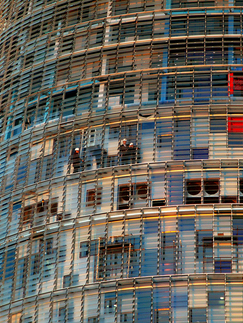-


Torre Agbar
The cigar-like shape of Barcelona’s 38-storey Torre Agbar was inspired, according to its principal architect Jean Nouvel, both by the image of a geyser rising into the air and the profile of the nearby mountain of Montserrat.
Images courtesy of Rafael Vargas
Architect Jean Nouvel Location Barcelona - Spain Company involved Alucoil Website http://www.alucoil.com
Nouvel also famously described this distinctive and some might say monumental structure as having “a phallic character”. Not surprisingly the Agbar tower, which closely resembles Sir Norman Foster’s 30 St Mary’s Axe, in London (aka “The Gherkin”) has attracted several nicknames in the eight or so years since it was officially opened by the King of Spain. These include "el supositori" (the suppository), "l'obús" (the shell) together with a few other that can only be described as scatological.
French architect Jean Nouvel designed the tower in association with Spanish architectural firm b720 Fermín Vázquez Arquitectos. It is located in the Poblenou neighbourhood of the city, at the Plaça de les Glòries Catalanes, and is named after its owner, the Agbar Group, a holding company whose interests include the Barcelona water company Aigües de Barcelona.
The building is supported by an interior concrete core and an exterior perimeter shell, also made of concrete. Both are load-bearing and together support a framework of radial steel beams. This arrangement allows floors to be free of structural columns.
It provides 30,000 m² of above-ground office space, plus an auditorium, and at 144.4m is the third tallest building in Barcelona, after the Arts Hotel and the Mapfre Tower.
The exterior of the building appears as if “pixelated” thanks to a mesh of almost square, approximately 90cm x 90 cm modules corrugated aluminium plate and stainless steel elements, lacquered in 25 different colours of Termolac polyester powder coating, applied by Alucoil at its Miranda de Ebro facility. Alucoil provide some 1,872m2 of Termolac sheets in thicknesses of both 2 and 3mm.
These lacquered aluminum plates were chosen for their durability and wide range of colours in which they could be produced, explains architect Pablo Garrido, from b720 Arquitectos, with the polished stainless steel specified “in certain areas to provide higher brightness”.
The windows also form pixels, he adds, and the interplay of colours and textures comprising the various pixels “generates a different chromatic composition depending on one’s position when viewing the building”.
Some 4,500 irregularly arranged window openings perforate the outer concrete shell. The aluminium façade overlies a layer of rockwool fixed to the exterior face of the structure’s perimeter wall. This is in turn overlain by a “second skin” of protective laminated glass slats “with varying degrees of transparency”. The slats tilt in accordance with their position on the building and as a result of “a thorough study of the incidence of the sun’s rays”.
They behave, according to b720 Arquitectos, “as a vibrant veil shrouding the tower”.
In terms of sustainability, the mass of the tower’s concrete walls and its relatively low proportion of windows, distributed in accordance with their orientation, provides an energy efficient building ideally suited to its location and the Barcelona climate, says Garrido.
The colours used for the façade cladding panels are standard RAL Design, he explains, but chosen by a team of collaborating artists.
The façade starts, near the building’s base, in warm reddish shades, said to “earthy” like the ground from which it emerges. These are replaced, gradually and irregularly on the upper floors by various shades of cooler blue, designed to blend naturally with both the Catalan sky and the adjacent Mediterranean. This colour change constitutes, according to b720 Arquitectos , “an exercise in dematerialisation”.
The exterior cylinder is upright to the 18th floor, from where it starts to curve inwards, gradually diminishing in floor size up to the 26th floor. Here the concrete stops and the building ends in a metal and and glass dome, some 142m above the ground. The upper six floors, built with concrete post-tensioned noggins of several thicknesses, are cantilevered from the central core, and sharing the vast space beneath the summit dome.
Images courtesy of Rafael Vargas










